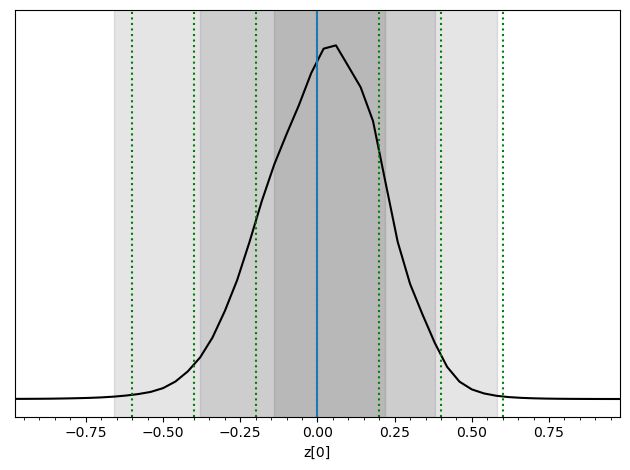This page was generated from notebooks/0F - Hyper parameters during training.ipynb.
F - Training hyper parameters#
Authors: Noemi Anau Montel, James Alvey, Christoph Weniger
Last update: 15 September 2023
Purpose: Making explicit all hyperparameters that govern the training and result.
Key take-away messages: All hyper-parameters relevant for training are easily accessible for the user. A good understanding of how these parameters affect inference results is important in order to produce high-fidelity results.
Code#
[1]:
import numpy as np
import pylab as plt
import swyft
import torch
import pytorch_lightning as pl
DEVICE = 'gpu' if torch.cuda.is_available() else 'cpu'
[2]:
torch.manual_seed(0)
np.random.seed(0)
We consider the simple problem of measuring the mean of a Gaussian that we started with.
[3]:
def get_samples(N):
z = np.random.rand(N, 1)*2-1 # Uniform prior over [-1, 1]
x = z + np.random.randn(N, 1)*0.2
samples = swyft.Samples(x = x, z = z)
return samples
Let’s now see how to pass network hyperparameters to swyft.SwyftModule. Since Swyft builds on PyTorch, we can use PyTorch functionalities for optimization. In the example below, we use the standard Adam algorithm to perform optimization steps, starting with a given learning rate lr, that can be passed through swyft.SwyftModule.
[4]:
class Network(swyft.SwyftModule):
def __init__(self, lr = 1e-3):
super().__init__()
self.learning_rate = lr
self.logratios = swyft.LogRatioEstimator_1dim(num_features = 1, num_params = 1, varnames = 'z', hidden_features = 128)
def forward(self, A, B):
logratios = self.logratios(A['x'], B['z'])
return logratios
[5]:
def run(N = 3000, shuffle = False, lr = 1e-2, batch_size = 32):
torch.manual_seed(0)
np.random.seed(0)
test_samples = get_samples(1000)
samples = get_samples(N)
dm = swyft.SwyftDataModule(samples, batch_size = batch_size, shuffle = shuffle)
trainer = swyft.SwyftTrainer(accelerator = DEVICE, precision = 64)
network = Network()
trainer.fit(network, dm)
test_result = trainer.test(network, test_samples.get_dataloader(batch_size = 64))
return test_result, network, trainer
Notice the printed learning rate decay.
[6]:
test_result, network, trainer = run(N = 2000, shuffle = False, lr = 1e-2, batch_size = 32)
GPU available: True (mps), used: False
TPU available: False, using: 0 TPU cores
IPU available: False, using: 0 IPUs
HPU available: False, using: 0 HPUs
/Users/cweniger/opt/anaconda3/envs/native2/lib/python3.9/site-packages/pytorch_lightning/trainer/setup.py:200: UserWarning: MPS available but not used. Set `accelerator` and `devices` using `Trainer(accelerator='mps', devices=1)`.
rank_zero_warn(
/Users/cweniger/opt/anaconda3/envs/native2/lib/python3.9/site-packages/pytorch_lightning/loops/utilities.py:94: PossibleUserWarning: `max_epochs` was not set. Setting it to 1000 epochs. To train without an epoch limit, set `max_epochs=-1`.
rank_zero_warn(
The following callbacks returned in `LightningModule.configure_callbacks` will override existing callbacks passed to Trainer: ModelCheckpoint
| Name | Type | Params
-----------------------------------------------------
0 | logratios | LogRatioEstimator_1dim | 67.6 K
-----------------------------------------------------
67.6 K Trainable params
0 Non-trainable params
67.6 K Total params
0.541 Total estimated model params size (MB)
/Users/cweniger/opt/anaconda3/envs/native2/lib/python3.9/site-packages/pytorch_lightning/trainer/connectors/data_connector.py:224: PossibleUserWarning: The dataloader, val_dataloader 0, does not have many workers which may be a bottleneck. Consider increasing the value of the `num_workers` argument` (try 8 which is the number of cpus on this machine) in the `DataLoader` init to improve performance.
rank_zero_warn(
/Users/cweniger/opt/anaconda3/envs/native2/lib/python3.9/site-packages/pytorch_lightning/trainer/connectors/data_connector.py:224: PossibleUserWarning: The dataloader, train_dataloader, does not have many workers which may be a bottleneck. Consider increasing the value of the `num_workers` argument` (try 8 which is the number of cpus on this machine) in the `DataLoader` init to improve performance.
rank_zero_warn(
The following callbacks returned in `LightningModule.configure_callbacks` will override existing callbacks passed to Trainer: EarlyStopping, ModelCheckpoint
Reloading best model: /Users/cweniger/Documents/swyft/notebooks/lightning_logs/version_48/checkpoints/epoch=5-step=300.ckpt
/Users/cweniger/opt/anaconda3/envs/native2/lib/python3.9/site-packages/pytorch_lightning/trainer/connectors/data_connector.py:224: PossibleUserWarning: The dataloader, test_dataloader 0, does not have many workers which may be a bottleneck. Consider increasing the value of the `num_workers` argument` (try 8 which is the number of cpus on this machine) in the `DataLoader` init to improve performance.
rank_zero_warn(
────────────────────────────────────────────────────────────────────────────────────────────────────────────────────────
Test metric DataLoader 0
────────────────────────────────────────────────────────────────────────────────────────────────────────────────────────
test_loss -0.5856146229232524
────────────────────────────────────────────────────────────────────────────────────────────────────────────────────────
[8]:
test_result, network, trainer = run(N = 2000, shuffle = True, lr = 1e-4, batch_size = 32)
GPU available: True (mps), used: False
TPU available: False, using: 0 TPU cores
IPU available: False, using: 0 IPUs
HPU available: False, using: 0 HPUs
The following callbacks returned in `LightningModule.configure_callbacks` will override existing callbacks passed to Trainer: ModelCheckpoint
| Name | Type | Params
-----------------------------------------------------
0 | logratios | LogRatioEstimator_1dim | 67.6 K
-----------------------------------------------------
67.6 K Trainable params
0 Non-trainable params
67.6 K Total params
0.541 Total estimated model params size (MB)
The following callbacks returned in `LightningModule.configure_callbacks` will override existing callbacks passed to Trainer: EarlyStopping, ModelCheckpoint
Reloading best model: /Users/cweniger/Documents/swyft/notebooks/lightning_logs/version_50/checkpoints/epoch=3-step=200.ckpt
────────────────────────────────────────────────────────────────────────────────────────────────────────────────────────
Test metric DataLoader 0
────────────────────────────────────────────────────────────────────────────────────────────────────────────────────────
test_loss -0.5863014549671752
────────────────────────────────────────────────────────────────────────────────────────────────────────────────────────
[12]:
x0 = 0.0
obs = swyft.Sample(x = np.array([x0]))
prior_samples = swyft.Samples(z = np.random.rand(10_000, 1)*2-1)
predictions = trainer.infer(network, obs, prior_samples)
swyft.plot_posterior(predictions, "z[0]", bins = 50, smooth = 1)
for offset in [-0.6, -0.4, -0.2, 0, 0.2, 0.4, 0.6]:
plt.axvline(x0+offset, color='g', ls = ':')
plt.axvline(x0);
The following callbacks returned in `LightningModule.configure_callbacks` will override existing callbacks passed to Trainer: EarlyStopping, ModelCheckpoint

Exercises#
Turn off the learning rate decay, and see how the posteriors look starting with different learning rates values, e.g. [1e-2, 1e-4, 1e-6]. How is the learning process affected by the learning rate?
[10]:
# Your results goes here
See what happens changing the early stopping patience.
[11]:
# Your results goes here
This page was generated from notebooks/0F - Hyper parameters during training.ipynb.